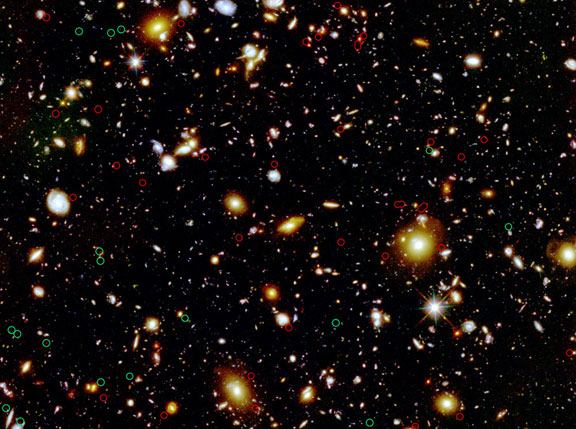Cosmic magnifying glasses could shed light on the origin of the Universe

Astronomers have shown how gravitational lensing allows us to see the faintest and most distant galaxies, helping us to understand the origin of the Universe.
The first gravitational lens, a phenomenon in which light from a distant object is bent around a massive foreground object, was discovered in 1979 by a team led by Dr. Dennis Walsh of The University of Manchester’s Jodrell Bank Observatory. Since then, astronomers have used gravitational lenses in many ways, including studying dark matter and as “Nature’s Telescope” to investigate galaxies in the distant universe.
In a letter to the journal Nature, Professor Shude Mao of the University of Manchester, along with Stuart Wyithe (University of Melbourne), Haojing Yan (Ohio State University) and Rogier Windhorst (Arizona State University), have calculated that gravitational lenses allow us to see farther into space than previously thought.
They argue that gravitational lensing makes faint sources more visible and this effect may be even more important than originally thought when looking at distant galaxies. Acting like a cosmic magnifying glass, gravitational lensing brings into clearer view galaxies which would otherwise be beyond the reach of even the largest telescopes.
Professor Mao added: “The magnifying effect of gravitational lensing gives us a much better chance of seeing very distant objects in the universe, otherwise too faint to see, and study them in far greater detail.”
In their Nature Letter, Professor Mao and his colleagues suggest that our measurement of the brightnesses and numbers of very distant galaxies is likely to be significantly distorted by the magnification caused by individual foreground galaxies much closer to us. But the exact ratio of numbers of magnified and unmagnified distant galaxies depends on various factors which astronomers are currently not certain about.
“Next-generation telescopes such as the James Webb Space Telescope, due to be launched in 2014, will be able to determine this effect more precisely”, says Professor Mao.
“By studying these extremely distant objects we can see far back in time. We aim to exploit the magnifying effect of gravitational lensing to reveal how galaxies like our own Milky Way emerged from the early Universe.”
Further information
The scientific paper describing these results is :
“A distortion of very high-redshift galaxy number counts by gravitational lensing” J. Stuart B. Wyithe (University of Melbourne), Haojing Yan (Ohio State University), Rogier A. Windhorst (Arizona State University), Shude Mao (University of Manchester and NAOC, China).
A preprint of the paper which was published in Nature on 13 Jan 2011 is available online.
More information on gravitational lensing is available on the Jodrell Bank website. Contacts
Dan Cochlin
Media Relations
The University of Manchester
0161 275 8387
daniel.cochlin@manchester.ac.uk









